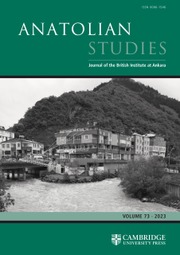Article contents
Sourcing the obsidian of prehistoric tools found in western Iran to southeastern Turkey: a case study for the sites of Eastern Chia Sabz and Chogha Ahovan
Published online by Cambridge University Press: 04 July 2014
Abstract
In this paper the results of X-ray fluorescence and neutron activation analyses for 18 obsidian tools from the archaeo¬logical sites of Eastern Chia Sabz and Chogha Ahovan in western Iran are presented. The archaeological sites have materials dating from the Pre-pottery Neolithic and Chalcolithic to Uruk periods. The evidence supports our conclusion that most of the obsidian found on western Iranian sites came from sources located near Lake Van in southeastern Turkey. These results suggest that the trade route for obsidian originated in southeastern Anatolia and moved southward along the western slopes of the Zagros Mountains into the central Zagros region.
Özet
Bu makalede, batı İran’daki Doğu Chia Sabz ve Chogha Ahovan arkeolojik yerleşimlerinden elde edilen 18 adet obsidiyen alet üzerinde yapılan X-ışını floresans ve nötron aktivasyon analizlerinin sonuçları sunulmaktadır. Bu arkeolojik Kanıtlar, batı İran'daki yerleşimlerde bulunan obsidiyenin çoğunun Türkiye'nin güneydoğusundaki Van Gölü yakınında bulunan kaynaklardan geldiği sonucunu desteklemektedir. Bu sonuçlar, obsidiyen ticaret yolunun güneydoğu Anadolu'dan başlayıp Zagros Dağları'nın batı yamaçları boyunca güneye doğru ilerleyip orta Zagros bölgesine ulaştığını göstermektedir.
- Type
- Articles
- Information
- Copyright
- Copyright © The British Institute at Ankara 2014
- 6
- Cited by


